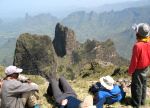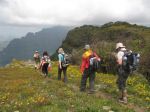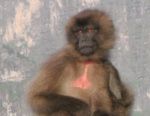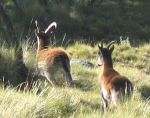The Landscape
Once upon a time, massive volcanic eruptions covered Ethiopia with a thick layer of volcanic rocks. In some areas of North Ethiopia highlands, this layer is claimed to be 3000m thick. Then came water, and through extensive erosion processes carved dramatic cliffs and deep ravines in the rock, leaving majestic jagged landscape.
The Simien Mountains (sometimes spelled Semien or Simen) are undoubtfully the most impressive mountain range in Ethiopia, and I would say – impressive in a global scale, yet – unknown to most mountain fans.
This basalt range rises from the surrounding 2500m high area, and towers to 3500 to 4500 meters high, with Ras Dashen (or Ras Dejen) the highest peak (4550m).
The most dramatic scenery is seen along the north escarpment, a sheer drop of 1000-1500m from the Simiens range to the lowlands below, creating wonderful viewpoints along it.The Simien Mountains National Park was declared in 1969, and the entire range was included in UNESCO World Heritage list in 1979.
Climate and best time for visit
Annual rainfall in the Simiens averages 1,550 millimeters. Rainy season is between June and mid September, with July-August the most rainy months. Occasional rains may occur between January and March. April and May are the hottest months, just before the rainy season.
October to December are the best times for hiking and trekking. October is particularly recommended since the mountains turn green following the rainy season, and cattle dots the landscape. With every day passing, the green is gradually replaced by yellow and brown colors.
Flora and Fauna
The Simien mountains’ unique features are not only the extraordinary scenery, but also unique flora and fauna.
Three endemic Ethiopian mammal species can be seen in the Simiens:
- Gelada (Theropithecus gelada, sometimes called the Gelada Baboon)
- The Walia Ibex (Capra walie)
- The Ethiopian Wolf (Canis Simensis, also known as Abyssinian wolf, red jackal, red fox, Simien fox or Simien jackal)
The Gelada is a species of Old World monkey found only in the Ethiopian Highlands, mainly in the Simien Mountains. Geladas, like their close relatives the baboons, spend much of their time foraging in grasslands, as they are herbivorous.
While the Geladas can be spotted in large harems decorating the impressive landscape, the Walia Ibex is a critically endangered species of ibex. Only about 400 individuals survive in the mountains of Ethiopia. With some patience, they can be spotted around Chenek camp.
The Ethiopian Wolf is endangered as well, with only about seven populations remaining, totaling roughly 500 adults, mostly in Ethiopia’s Bale mountains. Smaller populations exist in the Simien Mountains, and with some luck, a wolf may be spotted north of Geech camp.
Like all over Ethiopia, bird life is impressive in the Simiens as well. Over 60 species of birds can be spotted, some of them endemic such as the thick-billed raven, that will be happy to look for leftovers around your tent in the camp.
Look up to see the majestic Lammergeyers above you.








Leave a Reply